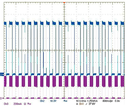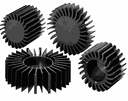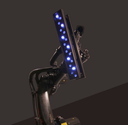Articles & Interviews
LpR Article
|
Jun 20, 2016
Concept of a Time-Proven LED Luminaire Design and Manufacturing Process by Lumitec Lighting
 While doing successful business has always been a tough job, it has become even tougher with the introduction of solid-state technology into the lighting industry. Besides high quality criteria, time to market has become a crucial success factor. Innovative processes and tools and, last but not least, a talented and inspired team are necessary. Angela Betancourt presents an approved process used by Lumitec Lighting.
Read more »
While doing successful business has always been a tough job, it has become even tougher with the introduction of solid-state technology into the lighting industry. Besides high quality criteria, time to market has become a crucial success factor. Innovative processes and tools and, last but not least, a talented and inspired team are necessary. Angela Betancourt presents an approved process used by Lumitec Lighting.
Read more »
LpR Article | Technologies
|
Jun 21, 2016
Optimization of SSL LED Devices by Osram Opto Semiconductors
LpR Article | Technologies
|
Jun 21, 2016
Safety Issues for LED Drivers with PWM Operation Modes by Product Approvals Ltd.
 In many cases LED drivers manage their output power with PWM controlled switched mode power supply-topologies. The output voltages are filtered and normally DC voltages with low ripple apply at the output connectors of LED drivers. During dimming these circuits can behave very differently and therefore safety issues may arise. Siegfried Luger, CEO at Luger Research e.U. and John Showell, Product Safety Consultant at Product Approvals Ltd. have a closer look at those operation modes and the requirements on voltage limits.
Read more »
In many cases LED drivers manage their output power with PWM controlled switched mode power supply-topologies. The output voltages are filtered and normally DC voltages with low ripple apply at the output connectors of LED drivers. During dimming these circuits can behave very differently and therefore safety issues may arise. Siegfried Luger, CEO at Luger Research e.U. and John Showell, Product Safety Consultant at Product Approvals Ltd. have a closer look at those operation modes and the requirements on voltage limits.
Read more »
LpR Article
|
Jun 21, 2016
Using Integrating Spheres Correctly to Measure LEDs
 LEDs have opened up new dimensions of design freedom, allowing architects and designers to give free rein to their creativity. Light-emitting diodes permit manifold design solutions as a light source in illumination products. However, a suitable measuring method for comparing key technical data is required in order to get the best out of the diversity of illumination products available. Mikolaj Przybyla from GL OPTIC, a Just Normlicht GmbH division, explains crucial product requirements and what to take care about when calibrating a measurement system.
Read more »
LEDs have opened up new dimensions of design freedom, allowing architects and designers to give free rein to their creativity. Light-emitting diodes permit manifold design solutions as a light source in illumination products. However, a suitable measuring method for comparing key technical data is required in order to get the best out of the diversity of illumination products available. Mikolaj Przybyla from GL OPTIC, a Just Normlicht GmbH division, explains crucial product requirements and what to take care about when calibrating a measurement system.
Read more »
LpR Article
|
Jun 27, 2016
Status of Micro- and Nanostructured 3D LED Technologies
 Conventional LEDs are planar, two-dimensional (2D) devices that emit light from a thin material layer at or near their flat surface. The vast majority of LEDs are made of GaN and InGaN material requiring expensive substrate wafers made of sapphire, silicon carbide or gallium nitride. The 3D WireLED technology uses silicon wafers for wafer diameters of 8 inches or larger. On each wafer, millions of vertical microwires and microrods of GaN are grown, each with a diameter of less than one micron. Mr. Arno Grabher-Meyer and Mr. Siegfried Luger from LED professional, talked with the General Manager of Aledia, Mr. Giorgio Anania about the status of this innovative technology.
Read more »
Conventional LEDs are planar, two-dimensional (2D) devices that emit light from a thin material layer at or near their flat surface. The vast majority of LEDs are made of GaN and InGaN material requiring expensive substrate wafers made of sapphire, silicon carbide or gallium nitride. The 3D WireLED technology uses silicon wafers for wafer diameters of 8 inches or larger. On each wafer, millions of vertical microwires and microrods of GaN are grown, each with a diameter of less than one micron. Mr. Arno Grabher-Meyer and Mr. Siegfried Luger from LED professional, talked with the General Manager of Aledia, Mr. Giorgio Anania about the status of this innovative technology.
Read more »
LpR Article
|
Jun 28, 2016
Contactless LED Technology
 While Contactless power distribution using electromagnetic induction technology is not new, it is rarely used in an LED illumination system. Alain Guimont, an IES member and Product Specialist at HEICO lighting™, one of the few companies that designs products based on this type of an approach, explains how it works and discusses the advantages of this technology.
Read more »
While Contactless power distribution using electromagnetic induction technology is not new, it is rarely used in an LED illumination system. Alain Guimont, an IES member and Product Specialist at HEICO lighting™, one of the few companies that designs products based on this type of an approach, explains how it works and discusses the advantages of this technology.
Read more »
LpR Article | Technologies
|
Jun 28, 2016
Reliability Oriented Design of LED-Based Light Sources
 The transition from traditional light sources to SSL systems requires a different design philosophy to achieve the advantages offered by LED light sources. The key approach is based on the parallel design of thermal, electrical, optical and spectral properties of the light source. Matteo Meneghini, Gaudenzio Meneghesso, Enrico Zanoni and Matteo Dal Lago from the Department of Information Engineering at the University of Padova, and Nicola Trivellin from LightCube SRL explain this approach including the importance of the electrical management of LEDs, comparing modulation techniques to constant current, differentiating between versatility and efficiency.
Read more »
The transition from traditional light sources to SSL systems requires a different design philosophy to achieve the advantages offered by LED light sources. The key approach is based on the parallel design of thermal, electrical, optical and spectral properties of the light source. Matteo Meneghini, Gaudenzio Meneghesso, Enrico Zanoni and Matteo Dal Lago from the Department of Information Engineering at the University of Padova, and Nicola Trivellin from LightCube SRL explain this approach including the importance of the electrical management of LEDs, comparing modulation techniques to constant current, differentiating between versatility and efficiency.
Read more »
LpR Article | Technologies
|
Jun 28, 2016
LED and Lens Degradation Through Volatile Organic Compounds
 In general, LEDs are very resistant light sources. Nevertheless, glues, conformal coatings, o-rings, gaskets, and potting compounds, all materials that are frequently used in the construction of LED based luminaires or lamps and often contain volatile organic compounds (VOCs) may have a negative impact on performance, reliability and lifetime. Edward Steinke, application engineer at Cree, explains the set of problems and how to prevent these issues based on Cree’s products, using their test kit components, as well as components for lamp and luminaire applications.
Read more »
In general, LEDs are very resistant light sources. Nevertheless, glues, conformal coatings, o-rings, gaskets, and potting compounds, all materials that are frequently used in the construction of LED based luminaires or lamps and often contain volatile organic compounds (VOCs) may have a negative impact on performance, reliability and lifetime. Edward Steinke, application engineer at Cree, explains the set of problems and how to prevent these issues based on Cree’s products, using their test kit components, as well as components for lamp and luminaire applications.
Read more »
LpR Article
|
Jun 28, 2016
Natural Design for Heat Sinks
 The luminous flux of LEDs decreases with the rise of the operating temperature. Therefore the dissipation of the heat is, aside from the efficiency of the LED chip itself, an essential part in the development of efficient LED systems. Christian Herbold and Cornelius Neumann from the Light Technology Institute at the Karlsruhe Institute of Technology analyzed natural inspired shapes and show an approach to heat sinks that combine high thermal performance with a high aesthetic value.
Read more »
The luminous flux of LEDs decreases with the rise of the operating temperature. Therefore the dissipation of the heat is, aside from the efficiency of the LED chip itself, an essential part in the development of efficient LED systems. Christian Herbold and Cornelius Neumann from the Light Technology Institute at the Karlsruhe Institute of Technology analyzed natural inspired shapes and show an approach to heat sinks that combine high thermal performance with a high aesthetic value.
Read more »
LpR Article | Technologies
|
Jun 28, 2016
OLED Technology in Lighting Applications
 Prototypes and niche applications with OLEDs for lighting have been demonstrated over the past few years. Now there are indications that OLED technology is ready for mass production or at least will be ready very soon. Franco Musiari, Technology Specialist at ASSODEL analyzed the current status and future perspectives of OLED technology.
Read more »
Prototypes and niche applications with OLEDs for lighting have been demonstrated over the past few years. Now there are indications that OLED technology is ready for mass production or at least will be ready very soon. Franco Musiari, Technology Specialist at ASSODEL analyzed the current status and future perspectives of OLED technology.
Read more »
LpR Article | Technologies
|
Jun 28, 2016
MOCVD Platform for Cost-Effective Production of GaN-based HB LEDs
 GaN-based blue and ultraviolet light emitting diodes (LEDs) are steadily becoming more widely used in solid-state lighting (SSL) applications [1-3]. Enabling dramatic energy savings when compared to contemporary incandescent bulbs and fluorescent lamps, these high-brightness LEDs (HB-LEDs) have a market potential in the billions of dollars. Yole Development estimates that by 2017, the market for LEDs will be approximately $75 billion [4, 5]. Shiping Guo, the Senior Technology Director of Advanced Micro-Fabrication Equipment Inc. presents a new approach to support this goal with a cost effective MOCVD solution for HB-GaN LED manufacturing.
Read more »
GaN-based blue and ultraviolet light emitting diodes (LEDs) are steadily becoming more widely used in solid-state lighting (SSL) applications [1-3]. Enabling dramatic energy savings when compared to contemporary incandescent bulbs and fluorescent lamps, these high-brightness LEDs (HB-LEDs) have a market potential in the billions of dollars. Yole Development estimates that by 2017, the market for LEDs will be approximately $75 billion [4, 5]. Shiping Guo, the Senior Technology Director of Advanced Micro-Fabrication Equipment Inc. presents a new approach to support this goal with a cost effective MOCVD solution for HB-GaN LED manufacturing.
Read more »
LpR Article | Technologies
|
Jun 28, 2016
High-Index Nanocrystals - Key to Next Generation Advancements in Lighting
LpR Article
|
Jun 29, 2016
Handheld Photometry Supports LED Lighting Design
 With SSL new dimensions were introduced to light measurement, especially concerning handheld light measurement tools. Norbert Harkam, General Manager at SalesLink GmbH, a Representative of UPRtek, explains what criteria have to be considered and what the requirements of a handheld photometer are.
Read more »
With SSL new dimensions were introduced to light measurement, especially concerning handheld light measurement tools. Norbert Harkam, General Manager at SalesLink GmbH, a Representative of UPRtek, explains what criteria have to be considered and what the requirements of a handheld photometer are.
Read more »
LpR Article | Technologies
|
Jun 29, 2016
Optical Lithography Method for Advanced Light Extraction in LEDs
 Objective material selection for various target applications is key for successful product development. Efficient light extraction features are crucial for highly efficient LEDs. Thomas Uhrmann and Harun Solak, et.al* from EV Group and Eulitha AG will demonstrate a novel lithography method, PHABLE™, that enables the printing of sub-μm patterns in a non-contact, proximity process.
Read more »
Objective material selection for various target applications is key for successful product development. Efficient light extraction features are crucial for highly efficient LEDs. Thomas Uhrmann and Harun Solak, et.al* from EV Group and Eulitha AG will demonstrate a novel lithography method, PHABLE™, that enables the printing of sub-μm patterns in a non-contact, proximity process.
Read more »
LpR Article
|
Jul 01, 2016
Thermal Management for LEDs Beyond Thermal Conductivity Values by Electrolube
 Specifically designed and formulated chemical products are widely used in the electronics industry for a vast array of applications. Jade Bridges, European Technical Support Specialist at Electrolube explains why such products have become an essential factor in ensuring the performance and quality of electronic devices, whether it is during PCB manufacture or for the protection of components or complete devices.
Read more »
Specifically designed and formulated chemical products are widely used in the electronics industry for a vast array of applications. Jade Bridges, European Technical Support Specialist at Electrolube explains why such products have become an essential factor in ensuring the performance and quality of electronic devices, whether it is during PCB manufacture or for the protection of components or complete devices.
Read more »
LpR Article
|
Jul 01, 2016
Choosing the Appropriate Heatsink for an Application by Fischer Elektronik
 Next to vibrations and moisture, temperature-related stress on electronic semiconductor elements is the most common cause of failure for electronic components and devices. Effective thermal management is obligatory to ensure durability, reliability and performance. Jürgen Harpain, Manager of Development at Fischer Elektronik explains how different types of heatsinks provide excellent solutions and which one is the appropriate solution for a given application.
Read more »
Next to vibrations and moisture, temperature-related stress on electronic semiconductor elements is the most common cause of failure for electronic components and devices. Effective thermal management is obligatory to ensure durability, reliability and performance. Jürgen Harpain, Manager of Development at Fischer Elektronik explains how different types of heatsinks provide excellent solutions and which one is the appropriate solution for a given application.
Read more »
LpR Article
|
Jul 01, 2016
Labeling and Certification Testing Issues by UL
 Arno Grabher-Meyer from LED professional summarizes several issues regarding certification and certification processes which were discussed with David Edwards, an expert in testing and compliance engineering for consumer products at UL.
Read more »
Arno Grabher-Meyer from LED professional summarizes several issues regarding certification and certification processes which were discussed with David Edwards, an expert in testing and compliance engineering for consumer products at UL.
Read more »
LpR Article | Technologies
|
Jul 01, 2016
How Silicones are Evolving to Meet the Growing Needs of the LED Lighting Industry by Dow Corning
LpR Article
|
Jul 01, 2016
The Influence of LED Emission Characteristics on the Efficiency of Lighting Systems by Osram Opto Semiconductor
LpR Article
|
Jul 01, 2016
